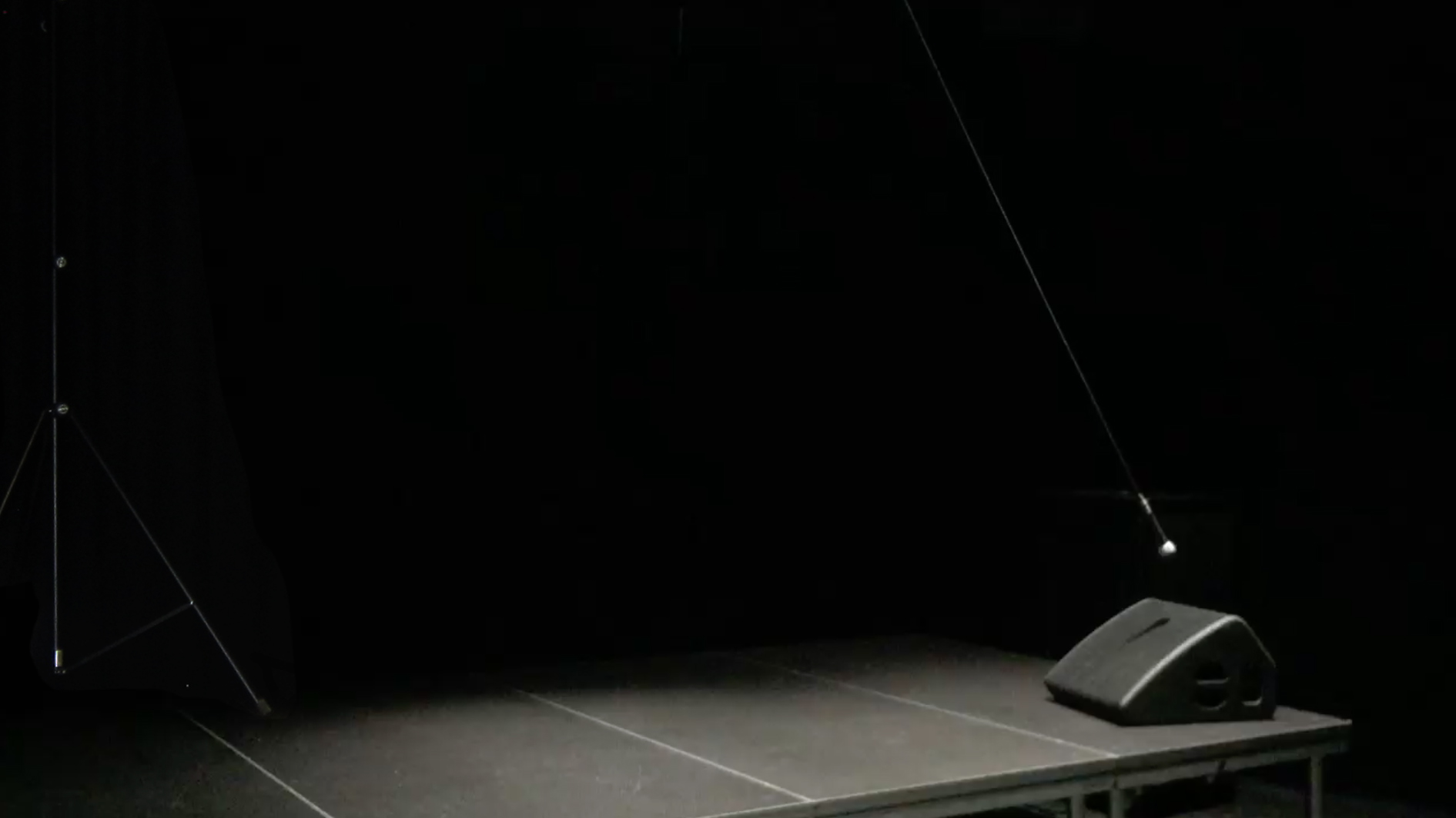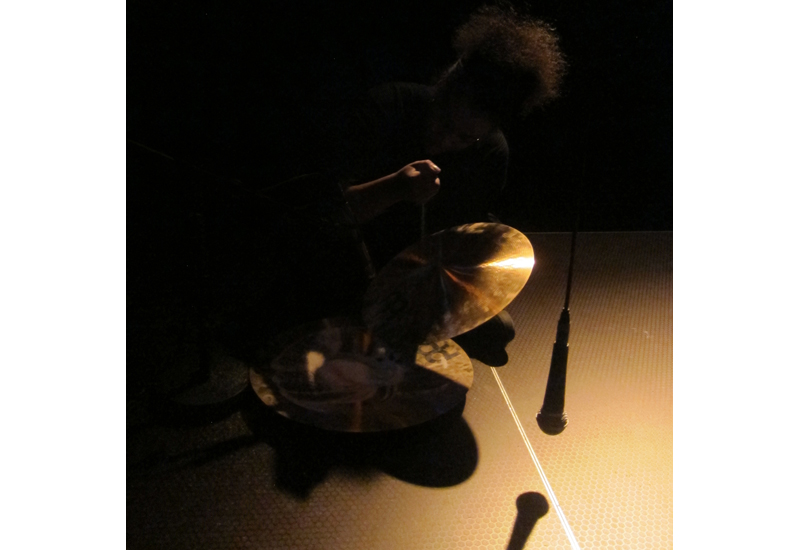selected works


"Like Norment's microphone and speaker, we are vulnerable. We might maintain calm if we keep things neat, and legislate distance between bodies, and between bodies and souls. If we violate that safe distance, we might screech and bristle. We might sing . We might progress."
- Marcus Civin, Art Forum 10 October 2016
Emanating from a single stage monitor softly aglow by a spotlight, a single female voice sings a short phrase from a lullaby, in hypnotic repetition. The words may seem meaningless, but the repetition of phrase and tone relays a pre-lingual message, a beckoning. Equally as mesmerizing, is the constant swing of a hanging microphone, back and forth like a pendulum. As the microphone swings over the monitor, the voice distorts into feedback that resounds throughout the environment. The intimate soothing voice, and calming situation of the lullaby and its fantasy, is repeatedly undermined by the threats of the external world.
“Lull” seeks to unfold the relationship between the lull of the dream-state, and the harsh realities of the world kept at bay using this intimate staging to contemplate ‘protection’ and social dissonance.
A composition for live performance was scored to be performed live with this installation by the Camille Norment Trio and vocalist Jernberg.
-
READ MORE +The lullaby is inevitably denotes an intimate space. The parental voice provides a sense of a stable and safe place and an inhabitable environment for the child drowsing off to sleep. The presence of the voice marks a difference between a safe place surrounded by an uncertain and chaotic world. At times the nature of the surrounding reality is directly reflected in the song’s lyrics – sometimes very frightening or even grotesque lyrics. Even though the themes of most lullabies are naïve and innocent, one finds striking examples of historical lullabies that depict the harsh and violent reality that contrasts the soothing tone of the song. The verse of these lullabies could sound a harsh, if not cruel tale, while paradoxically, the soothing tone, rhyme and hypnotic rhythm sought to entrance into a deep peaceful sleep.
One of the origins of the word ‘lullaby’ is believed to be the ancient Hebrew phrase ‘Lilith-abi’ sung by mothers (overtime becoming ‘Lilla-be’), meaning ‘Lilith be gone’. In addition to being sung, this phrase was written on an amulet placed around the child’s neck at night. Following legend, this phrase, this ritual was to protect the child from the demon Lilith who was cast down as Adam’s fist wife, for refusing to submit to a subservient position. In “Lull - So Ro”, the intimate soothing voice, and calming situation of the lullaby, unites in cycle, with the potential fears of the external world. This work was the first of a series of projects occupied with the lullaby.
Camille Norment Studio is grateful for the added support of Lydgalleriet and Østre in the co-production of this work.
Conversation with David Toop as part of the publication for the exhibition of "Lull - So Ro" at Lydgalleriet/Østre in Bergen
EXHIBITED
2017 San Francisco Museum of Modern Art. San Francisco, USA.
2016 Montréal Biennial. Montréal, Canada.
2016 Lydgalleriet. Bergen, Norway.
VIDEO FILES


"Like Norment's microphone and speaker, we are vulnerable. We might maintain calm if we keep things neat, and legislate distance between bodies, and between bodies and souls. If we violate that safe distance, we might screech and bristle. We might sing . We might progress."
- Marcus Civin, Art Forum 10 October 2016
Emanating from a single stage monitor softly aglow by a spotlight, a single female voice sings a short phrase from a lullaby, in hypnotic repetition. The words may seem meaningless, but the repetition of phrase and tone relays a pre-lingual message, a beckoning. Equally as mesmerizing, is the constant swing of a hanging microphone, back and forth like a pendulum. As the microphone swings over the monitor, the voice distorts into feedback that resounds throughout the environment. The intimate soothing voice, and calming situation of the lullaby and its fantasy, is repeatedly undermined by the threats of the external world.
“Lull” seeks to unfold the relationship between the lull of the dream-state, and the harsh realities of the world kept at bay using this intimate staging to contemplate ‘protection’ and social dissonance.
A composition for live performance was scored to be performed live with this installation by the Camille Norment Trio and vocalist Jernberg.
-
READ MORE +The lullaby is inevitably denotes an intimate space. The parental voice provides a sense of a stable and safe place and an inhabitable environment for the child drowsing off to sleep. The presence of the voice marks a difference between a safe place surrounded by an uncertain and chaotic world. At times the nature of the surrounding reality is directly reflected in the song’s lyrics – sometimes very frightening or even grotesque lyrics. Even though the themes of most lullabies are naïve and innocent, one finds striking examples of historical lullabies that depict the harsh and violent reality that contrasts the soothing tone of the song. The verse of these lullabies could sound a harsh, if not cruel tale, while paradoxically, the soothing tone, rhyme and hypnotic rhythm sought to entrance into a deep peaceful sleep.
One of the origins of the word ‘lullaby’ is believed to be the ancient Hebrew phrase ‘Lilith-abi’ sung by mothers (overtime becoming ‘Lilla-be’), meaning ‘Lilith be gone’. In addition to being sung, this phrase was written on an amulet placed around the child’s neck at night. Following legend, this phrase, this ritual was to protect the child from the demon Lilith who was cast down as Adam’s fist wife, for refusing to submit to a subservient position. In “Lull - So Ro”, the intimate soothing voice, and calming situation of the lullaby, unites in cycle, with the potential fears of the external world. This work was the first of a series of projects occupied with the lullaby.
Camille Norment Studio is grateful for the added support of Lydgalleriet and Østre in the co-production of this work.
Conversation with David Toop as part of the publication for the exhibition of "Lull - So Ro" at Lydgalleriet/Østre in Bergen
EXHIBITED
2017 San Francisco Museum of Modern Art. San Francisco, USA.
2016 Montréal Biennial. Montréal, Canada.
2016 Lydgalleriet. Bergen, Norway.
